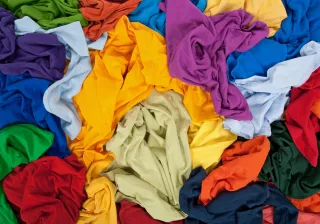Finland is an optimal place for breakthroughs in the textile industry. We have world-class know-how in digitalization and design. Furthermore, our land is full of forest, which can provide materials for sustainably produced textiles to meet the growing needs of consumers. By combining these resources, Finland has an opportunity to claim its place as a forerunner in the textile industry.
The role of corporate responsibility in all businesses and every industry domain is growing. Megatrends such as climate change have an impact on legislation and political decisions. Furthermore, citizens start having stricter requirements regarding the products they buy and the companies manufacturing those products.
Ecologically produced clothes interest consumers
Textile industry is one of the most polluting industry domains. It uses large quantities of water for growing the fibers. As part of the coloring and finishing products, the textile industry causes some 20% of the world’s clean water pollution. Furthermore, a huge amount of microfibers ends up in oceans annually. Dumping grounds are full of used clothes.
However, the times are changing and new disruptive companies have started to emerge in textile industry, also in Finland. Based on innovations originally from VTT, Infinited Fiber Company and Spinnova are excellent Finnish examples of such new generation textile companies. In addition to startups, also large corporations, for example, Stora Enso, Metsä Group and Fortum, are already heavily involved in the bio - and circular economy of the textile industry.
The industry talks about nearshoring, which means that the manufacturing is returning from far away countries back close to the consumer. Just as beer enthusiasts appreciate local microbreweries, also locally & ethically manufactured clothes are becoming more popular. Finland is full of forest, which produces suitable raw material for the textile industry. The question is how to turn the forest into fibers, into “yarn and fabric”.
Values such as authenticity, durability, recyclability, and production chain transparency are ever more important for the consumer. Youth, in particular, want clothes that are manufactured sustainably. This is a clear driver for locally and ethically produced clothes.
Green transition means putting digitalization to use
Drivers for the sustainable textile industry can be found also in political decisions, for example in EU’s recent industrial strategy for Europe. The strategy will set guidelines and regulations for companies’ operations in the upcoming years. Digitalization is one of the strategy’s cornerstones. It is a vital prerequisite of green transition and circular economy. We cannot reach the set objectives unless we harness digital innovations in the use of the industry. For example, efficient production of pulp-based fabrics demands advanced measurement technologies, analytics, data platforms, and robotics.
Finnish textile industry has worthwhile opportunities in combining world-class design with ethically produced materials and products. Furthermore, as a forerunner of digitalization, Finland has plenty of expertise of technologies needed for producing these kinds of sustainable fibers and fabrics.
Together with Finnish Textile and Fashion, companies and other research organizations, VTT has started to work on a roadmap for outlining the future of the textile industry in Finland. The main goal is to sharpen Finland’s vision on the future of the industry, of its business and investment opportunities. Finland has a great opportunity to be a front-row trendsetter for this new and ecological textile industry.









